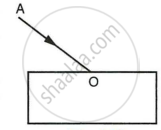Advertisements
Advertisements
प्रश्न
In the adjacent diagram, AO is a ray of light incident on a rectangular glass slab.

- Complete the path of the ray till it emerges out of the slab.
- In the diagram, mark the angle of incidence (i) and the angle of refraction (r) at the first interface. How is the refractive index of glass related to the angles i and r?
- Mark angles of emergence by the letter e. How are the angles i and e related?
- Which two rays are parallel to each other? Name them.
- Indicate in the diagram the lateral displacement between the emergent ray and the incident ray. State one factor that affects the lateral displacement.
उत्तर
- The ray's path through the glass slab is complete.
- `""^amu_g = "R.I glass" = sin i/sin r`

- Angle of emergence ∠e is marked ∠i = ∠e
- Emergent ray BD and incident ray AO are parallel.
- DE shows the lateral displacement.
The following factors affect lateral displacement:
- The angle of incidence.
- The glass slab's (or medium's) thickness.
- Refractive index of glass.
APPEARS IN
संबंधित प्रश्न
Four students P, Q, R and S traced the path of a ray of light passing through a glass slab for an angle of incidence 40° and measured the angle of refraction. The values as measured them were 18°; 22°; 25° and 30° respectively. The student who has performed the experiment methodically is
(A) P
(B) Q
(C) R
(D) S
Explain the term absolute refractive index of a medium and write an expression to relate it with the speed of light in vacuum.
Name a prism required for obtaining a spectrum of Ultraviolet light.
How is the angle of emergence related to the angle of incidence when prism is in the position of minimum deviation? Illustrate your answer with help of a labelled diagram using an equilateral prism?
The refractive index of air with respect to glass is expressed as `""_g μ_a=sin i /sin r`.
- Write down a similar expression for aμg in terms of the angles i and r.
- If angle r = 90°, what is the corresponding angle i called?
- What is the physical significance of the angle i in part (b)?
Four students A, B, C and D traced the paths of incident ray and the emergent ray by fixing pins P and Q for incident ray and pins R and S for emergent ray for a ray of light passing through a glass slab.

The correct emergent ray was traced by the student:
(1) A
(2) B
(3) C
(4) D
Name the phenomenon responsible in the following case:
Twinkling of stars
The diagram shows the path of a ray of light through a rectangular glass block placed in a liquid of uniform density.

(a) Does the light speed up or slow down in the glass,
(b) Give the reason for your answer.
